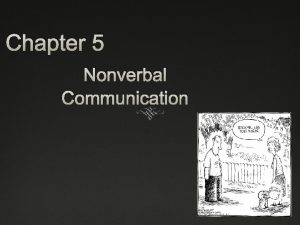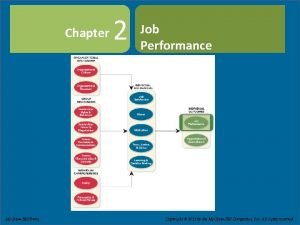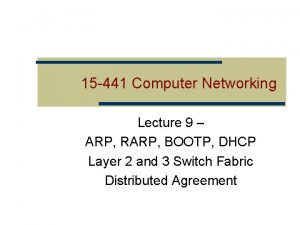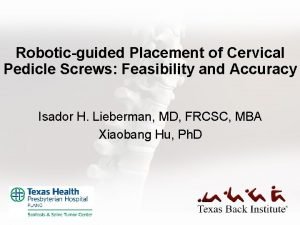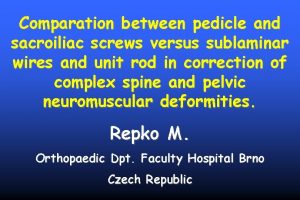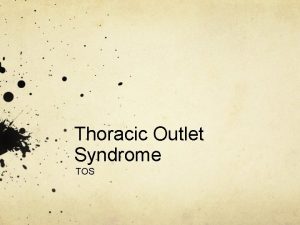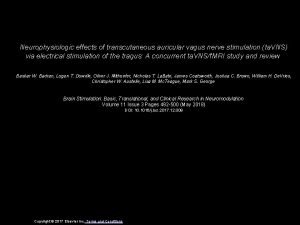Neurophysiologic Monitoring of Thoracic Pedicle Screws Intentionally Located












- Slides: 12

Neurophysiologic Monitoring of Thoracic Pedicle Screws Intentionally Located within the Spinal Canal. An experimental study in pigs LM Antón Rodrigálvarez, E Montes, J Burgos, G de Blas, C Barrios, E Hevia, C Correa, R Lorente, D Jiménez, I Regidor Hospital Clínico San Carlos, Madrid, Spain Hospital Ramón y Cajal, Madrid, Spain

Materials and Methods I To study and analyze neurophysiological monitoring signal changes occurring in the spinal cord during the intentionally placement of thoracic pedicle screws within the spinal canal Three experimental pigs Surgical exposure of the spinal cord with laminectomy at levels T 11, T 9 and T 6

Materials and Methods II Sequentail placement of thoracic pedicle screws on the lateral side of the spinal canal with slight displacement of the dural sac and the spinal cord from T 11, T 9, T 6 with continuous register of the spinal cord evoked potentials (3 pigs)

Materials and Methods III Distal to proximal placement of thoracic pedicle screws with severe displacement of the dural sac and the spinal cord, levels T 11, T 9 and T 6 (3 pigs)

Materials y Methods IV The spinal cord evoked potentials were registered for 20 minutes after the insertion of each pedicle screw If the spinal cord evoked potentials were completely lost, the pedicle screw was removed and monitoring of the spinal cord evoked potentials continued for another 15 minutes

Results I No changes in the spinal cord evoked potentials signal was observed in the 9 cases where thoracic pedicle screws were inserted on the lateral side of the spinal canal (11: 46: 07) 2. 79 m. A (11: 47: 29) 2. 79 m. A (11: 48: 43) 2. 79 m. A (11: 49: 59) 2. 79 m. A (11: 50: 14) 2. 79 m. A (11: 51: 28) 2. 79 m. A (11: 52: 43) 2. 79 m. A (11: 53: 17) 2. 79 m. A (11: 54: 45) 2. 79 m. A (11: 55: 24) 2. 79 m. A (11: 56: 21) 2. 79 m. A 20 u. V/D 0. 5 ms/D

Results II In the 9 cases where pedicle screws were inserted in the middle of the spinal canal, the signal of the spinal cord evoked potential was completely lost in all cases (11: 40: 35) 2. 07 m. A (11: 41: 11) 2. 07 m. A (11: 42: 50) 2. 07 m. A (11: 43: 38) 2. 07 m. A (11: 44: 06) 2. 07 m. A (11: 44: 41) 2. 07 m. A (11: 46: 04) 2. 07 m. A (11: 48: 33) (11: 50: 55) (11: 52: 08) 2. 07 m. A (11: 54: 02) 20 u. V/D 0. 5 ms/D

Results III Appearence of changes in the signal of the spinal cord evoked potentials; latency time: 10. 1 ± 2. 1 minutes Loss of the spinal cord evoked potentials signal; latency time: 11. 6 ± 1. 9 minutes No significant differences were observed among the different thoracic levels studied regarding the changes in the signal of the spinal cord evoked potential.

Results IV Spinal cord evoked potentials were restored in 7/9 cases after the removal of the thoracic pedicle screw with a latency time of 9. 7 ± 3. 0 minute N 1 (14: 38: 33) 2. 25 m. A (14: 40: 03) 2. 25 m. A (14: 42: 27) 2. 25 m. A (14: 49) 2. 25 m. A (14: 45: 11) 2. 25 m. A (14: 46: 34) 1. 92 m. A (14: 48: 29) 2. 31 m. A (14: 50: 46) 2. 31 m. A (14: 52: 00) 2. 31 m. A (14: 55: 00) 2. 31 m. A 20 u. V/D 0. 5 ms/D

Results V In 2/9 cases, removal of the pedicle screw did not restore the spinal cord evoked potentials signal after 15 minutes of monitoring (11: 40: 35) 2. 07 m. A (11: 41: 11) 2. 07 m. A (11: 42: 50) 2. 07 m. A (11: 43: 38) 2. 07 m. A (11: 44: 06) 2. 07 m. A (11: 44: 41) 2. 07 m. A (11: 45: 04) 2. 07 m. A (11: 47: 33) (11: 50: 55) (11: 55: 08) 2. 07 m. A (12: 00: 02) 20 u. V/D 0. 5 ms/D

Conclusions Thoracic pedicle screws invading the spinal canal and displacing the spinal cord moderately will not cause neurophysiological changes in the signal of the spinal cord evoked potentials Thoracic pedicle screws that cause a marked displacement of the spinal cord during their insertion will cause the loss of the spinal cord evoked potentials There is a relevant latency period between the physical changes caused to the thoracic spinal cord and the register of the neurophysiological monitoring changes Loss of spine cord evoked potential observed can be restored in some cases after the removal a malpositioned pedicle screw This experimental work in pigs supports clinical findings showing the difficulties to detect misplaced screws with current neurophysiologic monitoring techniques

Conflict of Interest Disclosure Euro. Spine 2011 Milan (Italy) October 19 - 21, 2011 Neurophysiologic Monitoring of Thoracic Pedicle Screws Intentionally Located within the Spinal Canal. An Experimental Study on Pigs. Name Country Relationship Disclosure Miguel Antón Elena Montes Jesus Burgos Gema de Blas Carlos Barrios Eduardo Hevia Carlos Correa Rafael Lorente Daniel Jiménez Ignacio Regidor Spain Spain Spain No Relationships No Relationships No Relationships
 Pedicle in plants
Pedicle in plants Dr john trantalis
Dr john trantalis Simple machines examples
Simple machines examples Different types of nails and screws
Different types of nails and screws Intentionally defective grantor trust diagram
Intentionally defective grantor trust diagram This page left intentionally blank template
This page left intentionally blank template The process of intentionally or unintentionally signaling
The process of intentionally or unintentionally signaling Intentionally defective grantor trust diagram
Intentionally defective grantor trust diagram Grats
Grats The most common form of production deviance is
The most common form of production deviance is When and where rarp is used intentionally
When and where rarp is used intentionally Rajesh shah thoracic surgeon
Rajesh shah thoracic surgeon Auscultatory triangle
Auscultatory triangle






